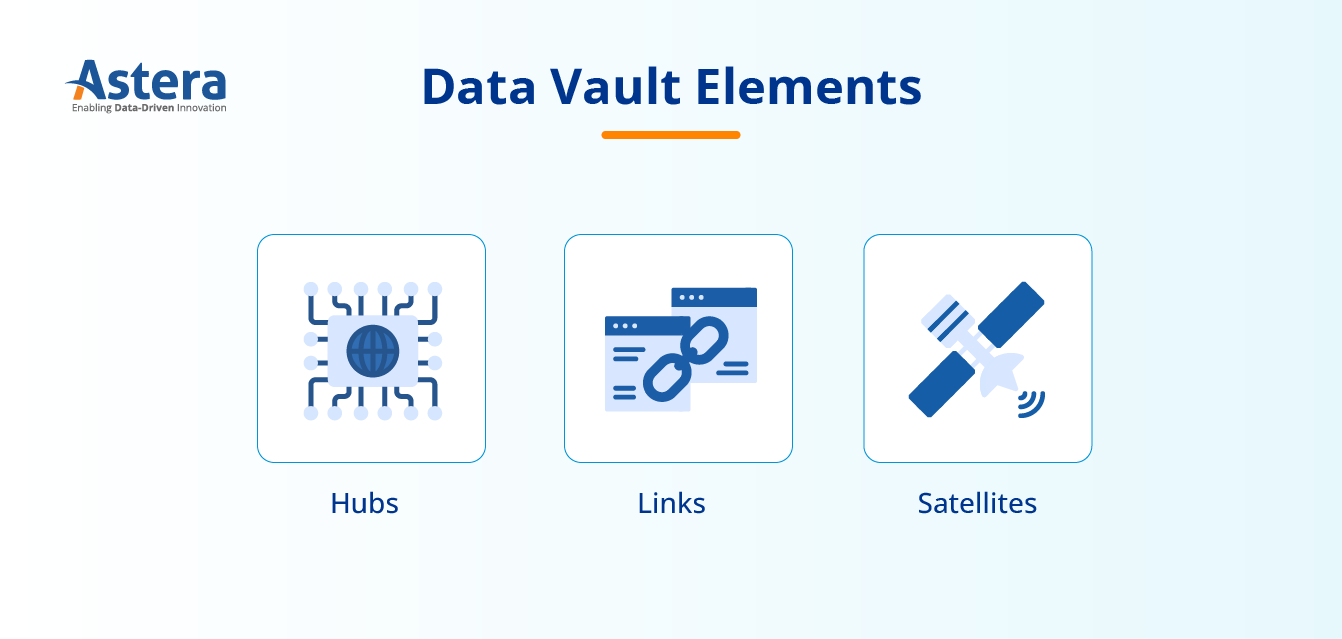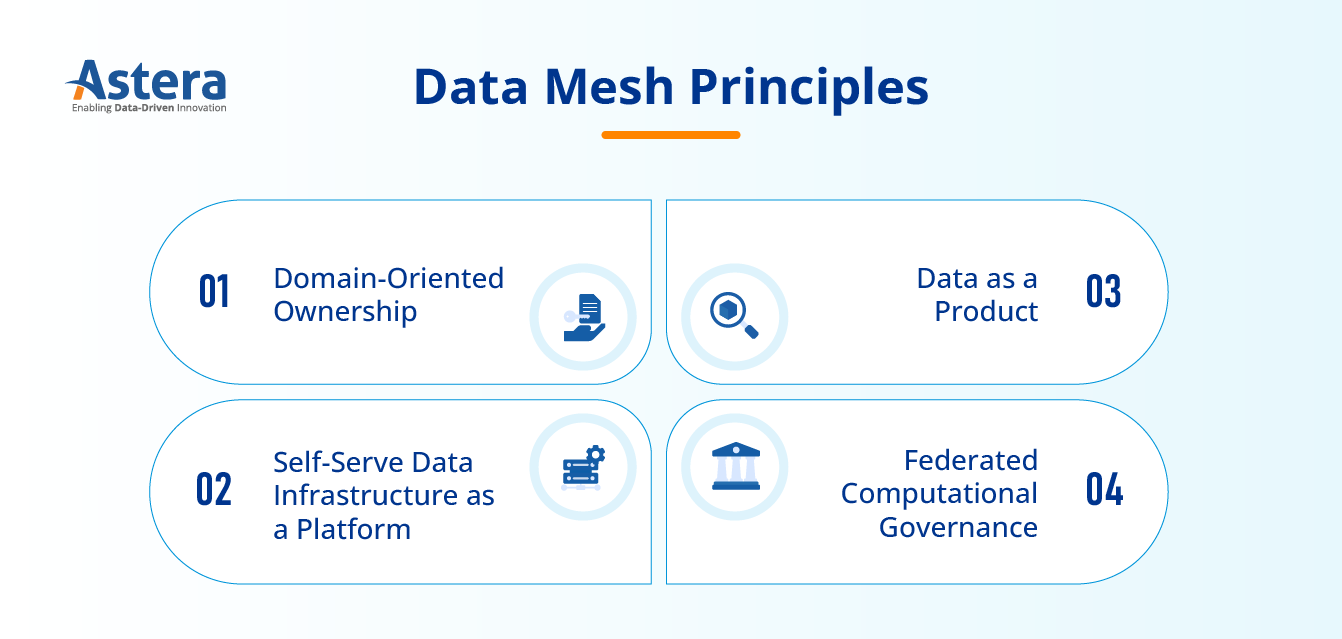
Data Vault vs. Data Mesh: Choosing the Right Data Architecture
Data volume continues to soar, growing at an annual rate of 19.2%. This means organizations must look for ways to efficiently manage and leverage this wealth of information for valuable insights. A solid data architecture is the key to successfully navigating this data surge, enabling effective data storage, management, and utilization.
Enterprises should evaluate their requirements to select the right data warehouse framework and gain a competitive advantage. That’s where Data Vault and Data Mesh come into play- each offering distinct approaches to managing and leveraging data.
To decide between the two, it’s essential to understand the evolving landscape of data architecture, the unique characteristics of each approach, and the practical applications that best suit specific business needs.
Understanding the Modern Data Architecture
Data architecture shapes how organizations collect, store, process, and leverage their data assets. It serves as the foundational framework that accommodates the diverse and ever-growing data streams originating from various sources, rendering traditional approaches obsolete and paving the way for future-ready data systems.
Modern data architecture is characterized by flexibility and adaptability, allowing organizations to seamlessly integrate structured and unstructured data, facilitate real-time analytics, and ensure robust data governance and security, fostering data-driven insights.
Think of data architecture as the blueprint for how a hospital manages patient information. It ensures that data from different departments, like patient records, lab results, and billing, can be securely collected and accessed when needed. In a modern data architecture, all this information is integrated into a central electronic health record (EHR) system.
The EHR system simplifies data retrieval for healthcare providers, leading to faster diagnoses, streamlined billing, and better patient care while also allowing for scalability and compliance with evolving regulations.
Selecting the right data architecture depends on the specific needs of a business. There is no one-size-fits-all solution, and the choice of architecture must align closely with an organization’s unique characteristics. Factors like data complexity, scalability, organizational culture, compliance obligations, available resources, and overall business goals should be considered to determine the right fit, enabling an organization to unlock the true value of its data assets.
Data Vault vs Data Mesh: An Overview
Now that we’ve established the importance of data architecture in today’s digital landscape let’s delve into two prominent approaches: Data Mesh and Data Vault.
Data Vault:
Data Vault architecture is an agile and flexible data modeling methodology used in data warehousing to handle complex and evolving data environments. It was developed by Dan Linstedt and has gained popularity as a method for building scalable, adaptable, and maintainable data warehouses.
Core Principles:
- Hubs: Hubs represent core business entities with unique identifiers.
- Links: Links connect hubs to show relationships between business entities.
- Satellites: Satellites provide detailed, descriptive information about the entities represented by hubs.
Data Vault emphasizes audibility and historical data tracking, making it well-suited for industries with regulatory compliance requirements and well-defined data structures, such as finance and healthcare. These sectors often have strict regulatory compliance requirements that demand secure storage of historical data, such as financial transactions or patient records.
Data Vault’s ability to provide a clear audit trail of data sources, transformations, and usage over time ensures organizations can meet these regulatory demands effectively.

Data Mesh:
Data Mesh is a relatively new concept in the field of data architecture and management. It was introduced by Zhamak Dehghani and focuses on decentralizing data ownership and management in large, complex organizations. This approach is well-suited to the complexity of modern data ecosystems, where data is spread across various entities.
- Domain-Oriented Ownership: Data ownership is decentralized, with individual domains or business units responsible for managing their data to ensure context and expertise alignment.
- Data as a Product: Data is curated and delivered with clear interfaces, treating it as a valuable product that can be self-served by other teams.
- Self-Serve Data Infrastructure as a Platform: A shared data infrastructure empowers users to independently discover, access, and process data, reducing reliance on data engineering teams.
- Federated Computational Governance: Governance standards are collaboratively applied across domains, ensuring data quality, security, and compliance while allowing for domain-specific customization.
Data Mesh is well-suited for industries with complex and decentralized data sources, such as e-commerce and manufacturing, because it provides a flexible framework that aligns with the diverse nature of their data streams. In these industries, data originates from various channels and often requires real-time analysis and scalability.
Data Mesh’s decentralized approach empowers domain-specific teams to manage their data efficiently, ensuring data quality, adaptability, and agility to meet industry-specific challenges effectively.

Data Vault vs Data Mesh: A Comparison
Let’s compare the two approaches to uncover the differences and similarities between them for improved understanding:
Differences:
- Infrastructure
Data Vault typically relies on a centralized infrastructure, often involving a data warehouse or similar centralized storage system. This centralized infrastructure simplifies data integration and management but may require significant initial investment.
In contrast, Data Mesh suggests a more distributed infrastructure approach, where individual domains manage data products. While this can reduce the need for a centralized infrastructure, it may necessitate investments in domain-specific tools and services. According to BARC, more than 90% of companies believe establishing domain-oriented ownership is relevant.
- Scalability
Data Vault achieves scalability by integrating new data sources into the centralized architecture, allowing for centralized control.
In contrast, Data Mesh facilitates scalability by enabling domains to scale their data products and services independently. This decentralized approach can be more flexible in handling varying data volumes and requirements across different domains.
- Data Ownership and Responsibility
Data Vault centralizes data ownership, strongly emphasizing data lineage and traceability. In this approach, the data warehousing team is typically responsible for ensuring data quality and consistency.
In contrast, Data Mesh decentralizes ownership, placing the responsibility on individual domains. However, governance remains essential in a Data Mesh approach to ensure data quality and compliance with organizational standards.
- Collaboration and Cross-Functionality
While both approaches encourage collaboration among data professionals, Data Vault does not inherently emphasize cross-functional teams. It primarily focuses on centralized data management.
Conversely, Data Mesh actively encourages cross-functional teams, promoting collaboration between data engineers, data scientists, and domain experts to ensure that data products align with business needs and goals.
- Use Cases
Choosing between a Data Vault and a Data Mesh often depends on specific use cases. Data Vault is well-suited for scenarios that require rigorous historical tracking, data integration, and data quality assurance. It excels in situations where a centralized and structured approach to data management is necessary.
In contrast, Data Mesh is particularly relevant for organizations with a distributed data landscape, where data is generated and used by multiple domains or business units. It thrives in environments where agility, autonomy, and collaboration among domain teams are essential for driving insights and innovation.
Similarities:
- Data Integration
Both Data Vault and Data Mesh address the challenge of integrating data from diverse sources within an organization. They acknowledge the need to combine data from various systems and make it accessible for analysis.
- Data Quality
Both approaches emphasize data quality and governance. Data Vault includes mechanisms for data quality control within the centralized data repository, while Data Mesh promotes data product quality through decentralized ownership.
- Flexibility
While they differ in their degree of flexibility, both Data Vault and Data Mesh aim to provide solutions that are adaptable to changing data requirements. Data Vault achieves this through versioning and change management, while Data Mesh relies on domain teams to adapt their data products.
- Data Democratization
Both approaches aim to improve data accessibility and availability for users across the organization. Data Vault does this by creating a centralized repository accessible to authorized users, while Data Mesh encourages decentralized data ownership and access to foster data democratization.
- Use of Modern Technologies
Both Data Vault and Data Mesh often leverage modern technologies such as cloud computing, containerization, and orchestration to support their respective architectures.
| Aspect | Data Vault | Data Mesh |
| Approach | A centralized approach to data warehousing, which consolidates data into a centralized repository. | A decentralized approach that promotes distributed data ownership and autonomy suited for modern, distributed data ecosystems. |
| Core Components | Utilizes Hubs, Links, and Satellites to provide a structured and organized data architecture. | Employs Domain Ownership and Data Products to distribute data ownership and provide agility in data management. |
| Historical Tracking | Strong emphasis on capturing and maintaining historical data changes for analytical purposes. | Lesser emphasis on historical tracking, focusing more on domain-specific data products. |
| Scalability | Horizontal scalability achieved by adding data sources centrally to the existing architecture. | Vertical scalability, allowing domains to scale their data products independently based on their needs by adding more resources to individual microservices or components. |
| Flexibility | Offers adaptability to evolving data sources while maintaining a consistent structure. | Highly adaptable to changes in data types, sources, and business requirements. |
| Data Ownership | Centralized data ownership and control within a central data warehousing team. | Decentralized data ownership, placing responsibility within individual domains or business units. |
| Collaboration | Encourages collaboration primarily within data teams. | Promotes cross-functional collaboration between data professionals and domain experts. |
| Data Governance | Enforces centralized data governance and control policies. | Requires domain-specific governance frameworks to maintain data quality and standards. |
| Data Quality | Emphasizes strong data quality assurance practices. | Data quality can vary between domains, necessitating domain-specific efforts. |
| Data Security | Implements centralized security measures and controls. | Requires domain-specific security considerations to safeguard data. |
| Discoverability | Centralized metadata management simplifies data discoverability. | Domain-specific data discovery tools and processes are employed. |
| Resource Allocation | Concentrates resources on the central data warehouse and associated teams. | Distributes resources across domains, necessitating careful resource planning. |
| Adaptation to Variety | Best suited for structured data, predefined schemas, and traditional data sources. | Adaptable to diverse data types, sources, and unstructured data. |
| Cultural Shift | Requires limited cultural change, aligning with traditional data warehousing practices. | Requires a cultural shift towards domain-oriented collaboration and ownership. |
| Use Cases | Well-suited for use cases requiring historical tracking, structured data, and centralized data management. | Relevant for use cases in diverse and distributed data environments where agility, autonomy, and collaboration among domains are essential. |
Key Factors for Data Vault vs Data Mesh Implementation
The decision to choose the right architecture depends on several factors. Some of them include:
Data Complexity
Data complexity encompasses various aspects, such as data types, sources, and relationships. Understanding data complexity is vital when selecting a data management approach. Data Mesh’s adaptability may be preferable for highly complex data landscapes, while Data Vault is better suited for structured and well-defined data.
Organizational Culture
An organization’s culture plays a significant role in its data management approach. It is crucial to assess whether it leans more centralized or decentralized and its readiness for change and experimentation. Data Vault better fits centralized cultures valuing control, while Data Mesh fosters decentralization, collaboration, and innovation.
Compliance Obligations
Compliance, including data privacy regulations and industry standards, substantially impacts their data management choices. It’s crucial to ensure that their approach aligns with compliance requirements. Data Vault offers centralized control and auditing for compliance-driven environments, while Data Mesh may require robust governance mechanisms to meet regulatory obligations.
Cost Considerations
Organizations must evaluate the overall cost implications covering software, hardware, cloud services, personnel, and ongoing maintenance expenses. They should assess which approach aligns better with the organization’s budget and financial objectives. Data Mesh’s cloud-native approach may have different cost dynamics compared to Data Vault’s traditional data warehousing model. A thorough cost analysis is pivotal in making the right choice.
User Training
Organizations must assess user training needs when choosing between Data Vault and Data Mesh. Each approach demands unique skill sets and workflows from data analysts, scientists, and business stakeholders. Data Mesh may require training in domain knowledge and collaboration due to its cross-functional focus, while Data Vault may necessitate expertise in traditional data warehousing and ETL processes. A study by Eckerson Group reveals that only 65% of Data Vault adopters report receiving training on the Data Vault 2.0 solution, highlighting a potentially critical gap and the significance of user training.
Overall Business Goals
An organization’s business goals should serve as a guiding principle in its data management approach. The organization must determine whether it aims for efficiency, agility, innovation, or a combination of these factors. Data Vault is well-suited for efficiency and structured reporting, while Data Mesh aligns with innovation and rapid adaptation to changing business needs.
Can Data Vault and Data Mesh Co-exist?
Data Vault and Data Mesh are not mutually exclusive; instead, they can be used together to create a robust data architecture. These two concepts address different aspects of data management and can be used in tandem to manage modern data ecosystems effectively.
While Data Vault primarily focuses on the technical aspects of data organization, Data Mesh emphasizes the organizational and cultural aspects of effective data management. They can coexist by serving different but complementary roles within the organization’s data management strategy.
For instance, an organization might employ a Data Vault to consolidate and manage structured data from multiple sources within a centralized data warehouse. Concurrently, it could embrace Data Mesh principles for handling decentralized, domain-specific data sources that don’t neatly fit into the centralized warehouse model. This hybrid approach offers organizations the flexibility and scalability needed to manage both structured and unstructured data while optimizing data quality, accessibility, and governance across the organization.
A Final Word
The choice between Data Vault vs Data Mesh, or a combination of both is about tailoring the data strategy to an organization’s unique needs. Data Vault brings structure and governance to your data, ensuring reliability and consistency. On the other hand, Data Mesh introduces agility and decentralization, allowing for flexibility in managing diverse data sources.
It’s not an either-or decision, but rather finding the right blend that suits your specific requirements. Striking this balance empowers organizations to harness the power of their data, not only to meet their immediate needs but also to navigate the ever-evolving data landscape with confidence, ultimately achieving their long-term objectives.
When it comes to finding the right data architecture, Astera stands out as a trusted provider. It offers a unified, metadata-driven approach, making it the go-to choice for organizations looking to efficiently build, manage, and optimize their data warehousing architecture. With Astera’s no-code solution, businesses can easily design, develop, and deploy high-volume data warehouses in days, enabling them to stay ahead in today’s data-driven landscape.
Learn more about how Astera Data Warehouse Builder simplifies data management!
Build Your Data Warehouse Effortlessly With a 100% No-Code Platform
Build a fully functional data warehouse within days. Deploy on premises or in the cloud. Leverage powerful ETL/ELT pipelines. Ensure data quality throughout. All without writing a single line of code.
Learn More! Astera AI Agent Builder - First Look Coming Soon!
Astera AI Agent Builder - First Look Coming Soon!
